It Is Time To Consider A More Accurate And Comprehensive Cost/Benefit Analysis Of Electric Versus Diesel-Powered Dredges.
By Cash McCloy
In 2021 it is time to consider a more accurate and comprehensive cost/benefit analysis of electric versus diesel-powered dredges. Many variables have changed and improved in recent years, and consistent patterns have emerged over time about diesel engine maintenance. A new updated analysis that weighs the pros and cons of electric versus diesel power really must include additional current real-world variables other than just the cost of fuel.
Thanks to Federal Tier 4 Final diesel engine requirements that went into full effect in 2017, the cost of a new Tier 4 compliant diesel engine, the engine controllers, and supporting equipment is now much more expensive than prior incarnations and is closely comparable to the cost of a new electric motor, variable frequency drive (VFD) and supporting electrical gear.
Now that the price delta between diesel engines and electric motors has narrowed considerably, it is prudent to reexamine the economic advantages of electric dredge ownership while also attributing a more appropriate amount of weight to the mounting number of ecological advantages that electric powered dredges provide.

Electric dredge located in Ohio.
Fuel Cost Savings
The cost for a gallon of diesel fuel compared to the cost of a kilowatt hour of electricity frequently provides a “perceived” economic advantage. We contend that the perceived value associated with diesel fuel as an economic advantage is just not true.
Realistically diesel fuel costs escalate and fluctuate wildly based on many variables including but not limited to the political ideologies of politicians in power, international supply/demand for crude, the time of year, O&G procurement and refinement technologies, ancillary costs associated with global warming politics, and more.
At press time the national average of on-road diesel was $3.344 according to the U.S. Energy Information Administration, up almost a full dollar from the same time last year.
Compare that to the cost of kilowatt energy. For April 2021, the national average for industrial electricity was $6.77 cents per kilowatt hour, up from 6.40 per kilowatt hour(kWh) a year ago.
In the event you are contemplating a new dredge or perhaps wondering about converting your diesel-powered dredge to electric, this article will highlight the tremendous savings and advantages to be had with electric power verses diesel, not only with fuel costs, but in several other important ways.
Prior to exploring other economic advantages, let’s take a closer look at a cost-benefit analysis focused onlt on the cost of fuel.
Consider the following cost comparison table, which assumes a conservative average cost of diesel at $2.50 per gal. versus $0.065 per kWh, which were the averages in 2018.
The Conversion Question
Many dredge owners reading this have given consideration at some point to converting their diesel dredge over to electric power. Admittedly, the payback horizon for the conversion scenario is a bit longer due to the difficulty of recapturing money that was previously invested in the diesel system, and also factoring in the costs associated with being shut-down for a period to allow time for the conversion to take place (approx. 30 days).
Due to the much higher cost of Tier 4 engines, there currently is a strong demand for used Tier 3 engines, so you may be able to achieve some recapture of your investment by selling the used diesel engine. However, it may still take six months to a year to recoup your investment for an electric conversion if your payback timeline is based solely upon fuel costs savings alone.
With a more comprehensive real-world analysis of the tremendous savings of an electric powered dredge in addition to the fuel costs savings, the payback horizon shortens considerably and becomes very compelling, as we shall now see.
The Real Cost of Diesel
What we find curiously absent from nearly all electric versus diesel cost-benefit-analyses’ is the significant costs associated with maintaining a diesel engine. Once those true costs are accurately and appropriately applied, the case in favor of converting your existing diesel dredge to electric, or for acquiring a new electric powered dredge, becomes much harder to ignore.
For example, all experienced dredge operators will readily affirm that diesel engines demand ongoing repairs, parts and constant attention. In addition, diesel engines will eventually be the culprit of a production shutdown at some point. When? For how long? How much will the repairs and lost revenue cost? Who knows, but what is known for certain is that regardless of the make and model, a diesel engine will eventually fail or require significant maintenance and trigger a negative cash flow event. It’s only a question of when?
In this day of age, locating and hiring workers who have the skill and dedication to provide quality diesel engine maintenance/repairs is a tall order. Hiring quality workers is hard enough as it is but locating someone with the aptitude and commitment to take care of a diesel engine can be quite a challenge.
As with any mining operation, time literally equates to money. The costs associated with man-hours, parts, repairs and production interruptions as a result of diesel engine problems is significant, and once again, it is very mysterious to us that these data-points are omitted in most diesel verses electric calculations.
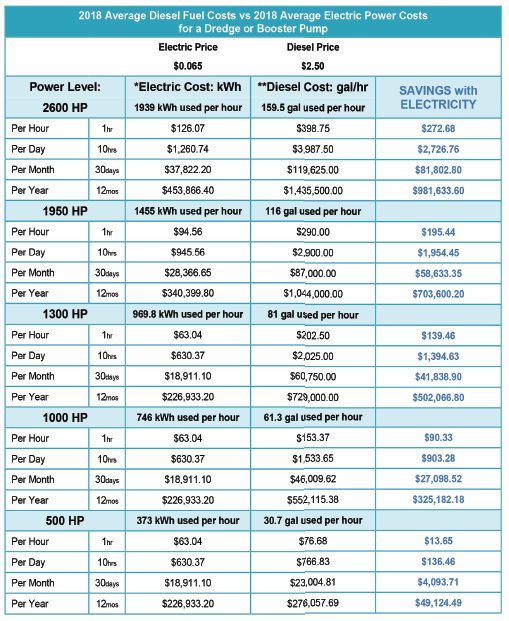
Why is This?
Also, we find it quite odd that the large chasm between the useful life of diesel engines (10,000-20,000 hours) and that of electric motors (40,000-50,000 hours) is typically not taken into consideration as well.
It can be challenging to predict the total cost of operating a diesel engine, but an experienced operator knows that the true lifetime costs can be very high. The best diesel engines in the world are maintenance intensive and are likely to require a complete over-haul or rebuild at least once during the arc of its useful life.
Other expense items that are not typically contemplated:
- Transporting diesel to the dredge.
- Downtime to refuel, and perform oil changes.
- The proper disposal of used oil.
- Oil Spill cleanups and exposure to municipal/government liabilities.

Electric Economics
In truth, the operating maintenance costs of an electric motor is nearly nonexistent. Electric motors are virtually maintenance free, requiring a squirt of grease in the housing bearing once a month. They are infinitely more reliable for much longer periods of time. Also, electric motors are as simple and easy to operate as an on/off switch.
Electric dredge operators routinely experience many benefits that translate to huge savings for their mining operations, many of which are difficult to calculate an exact dollar amount for, however, they are very tangible and include the following:
- Reduced maintenance costs.
- Reduced man hour costs.
- Reduced unscheduled shutdowns.
The cost input variables are yours to play with as each operation is unique, and you may wish to consider various timelines. Realistic cost estimates will help you to accurately predict your pay-back horizon for a new dredge or an electric conversion project. Once you recoup your initial investment, then the savings really begin to accumulate and compound going forward.
The savings from a new electric dredge or booster should be experienced almost immediately since the initial cost is relatively the same for a new diesel Tier 4 Final compliant dredge or booster. The savings and operational advantages are phenomenal long-term.
Our statements about the operational/maintenance complexities and costs associated with diesel engines versus electric motors are not mere academic opinions. They are demonstrable facts based on 20+years of real-world experience in designing, building and repairing diesel and electric dredges for aggregate mining operations coast-to-coast.

A More Comprehensive Analysis of Operating Costs

The Eco Advantages of Electric
At this point in time there can be no doubt that the U.S. aggregates industry is facing ever mounting scrutiny and pressure from local, state and federal authorities to reduce or eliminate the actual, or perceived, negative impact mining operations may have on the ecosystem.
The bureaucratic requirements for attaining permits to start or expand mining operations can often be frustrating and challenging when dredging is involved. In addition, local activist groups and residential or commercial neighbors can frequently create unnecessary alarm and roadblocks to attaining permits.
An electric powered dredge can go a long way to address these objections and provide ammunition to effectively mitigate ecological impact concerns. It also improves your public relations image by demonstrating a “good-faith best-effort” to be a good operator, neighbor and a positive member of the community.
Ultimately, a powerful argument can be made to grant mining permits for dredging operations since an electric dredge completely eliminates the following ecological concerns:
- Air pollution.
- Noise pollution.
- Water pollution.

Summary
Important benefits to owning and operating electric powered dredges and booster pumps that you should consider:
Ecological Benefits
- Elimination of diesel engine air pollution.
- Elimination of fuel spill water pollution.
- Considerable reduction in noise pollution.
- Compliance with federal, state and local standards for emissions, water and noise.
Economic Benefits
- Electric powered dredges are now roughly equal in cost with Tier 4 dredges.
- Reduction or elimination of engine maintenance costs.
- Easier to locate and hire qualified workers.
- Electric motor useful life can be two to three times greater than diesel engines.
- Improve production output with reduced maintenance and downtime.
- Consistent production and cash-flow predictability.
- Improve customer satisfaction.
- The resale value and demand for used electric dredges is much greater.
- Ease of use. A simple on/off switch and an occasional squirt of oil.
- Happier, less encumbered and less stressed operations and maintenance personnel.
- Elimination of fuel transport costs.
- Elimination of fuel spill liability and cleanup costs.
- Elimination of shutdown costs for refueling and oil changes.
- Elimination of liability for non-compliance of emission, water, and noise pollution statutes.
- Improved public relations image with neighbors, environmental authorities and activists.
- May contribute to making mining permits easier to obtain.
- Acquire LEED points, and boost your reputation for government contracts.

Electric power conversion retrofi t in Iowa.
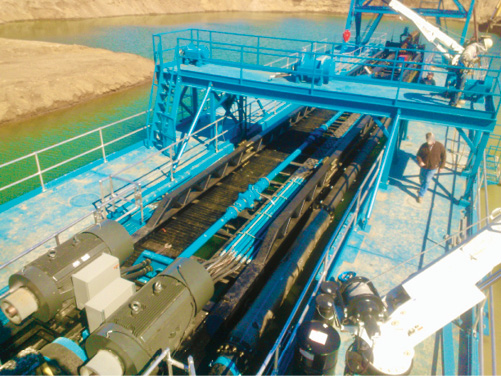
Electric motors mounted on ladder.
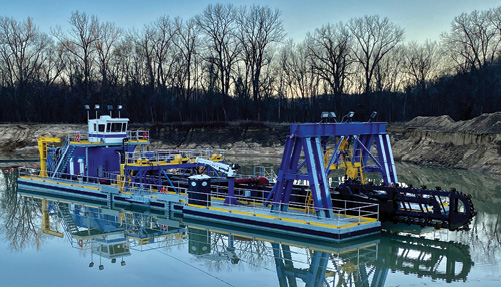
Electric Chain-Ladder dredge outside St. Louis.
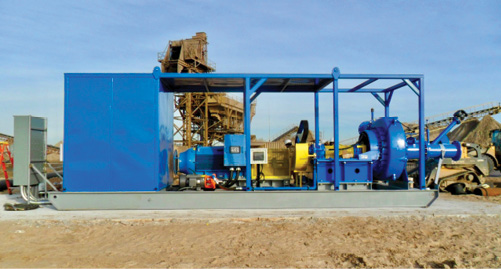
Electric Booster Pump Station located in Ohio.
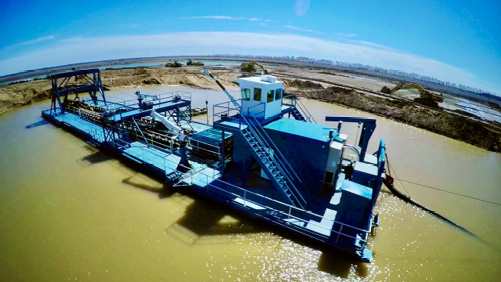
Electric dredge in Illinois.
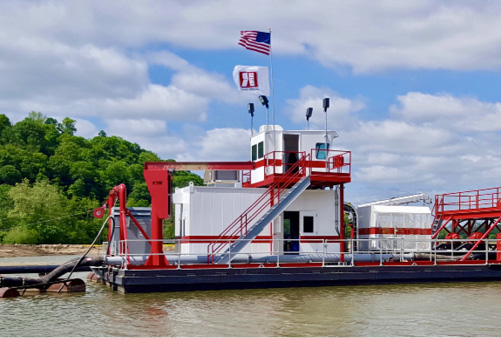
Side view of MCC room, motor enclosure and operator’s cab.
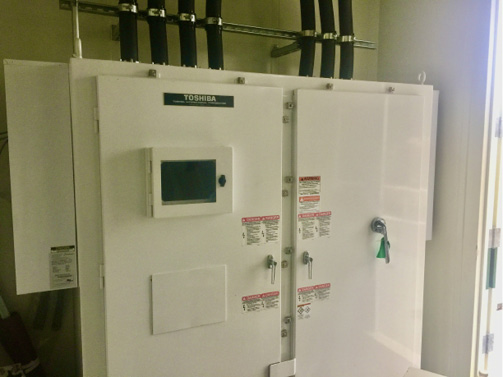
Variable Frequency Drive (VFD).
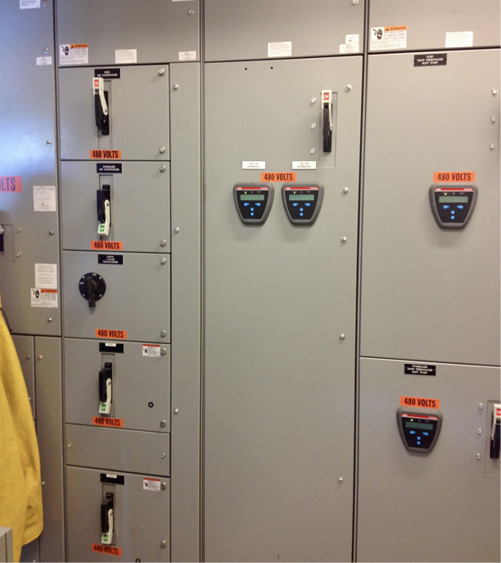
Motor Control Center (MCC).
Cash McCloy is vice president of sales and marketing for CDW. He can be reached at 785-220-0555 or [email protected].
